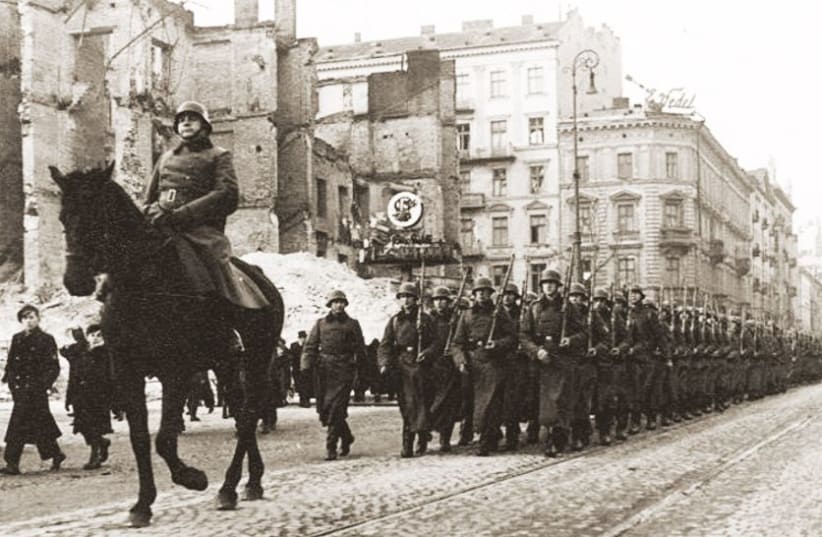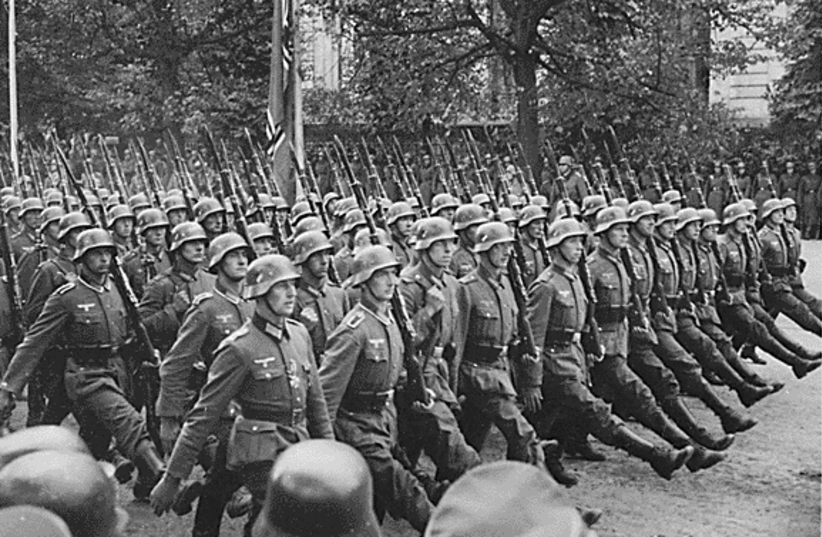When Karla McCabe was a child in East Germany in the 1970s and ‘80s, she knew her grandfather had been a German soldier in World War II. But exactly what he did during those years was not a topic of discussion in her family.
Nine years after his death, when McCabe was 18, she inherited part of his proud stamp collection. She rifled through relics of a lifelong hobby, including his first stamp album from 1926, an assortment of envelopes and, finally, 36 postcards that made her shudder. Though she could not read them, she recognized Hebrew letters and Jewish names. All the postcards were addressed to one place: The Chachmei Lublin Yeshiva.
McCabe didn’t know it at the time, but the yeshiva was a famed Jewish house of study in Poland before the Holocaust. And there in her hands, she held rare fragments of a world ruptured by her grandfather’s army. She soon learned that as the Jews of Lublin were murdered, her grandfather — stationed in the district until 1941 — fished some of their letters from a trash bin to augment his stamp collection.
Yeshiva marks return of postcards with ceremony
On April 11, more than 80 years later, McCabe finally returned the postcards to their home in a ceremony at the former Lublin Yeshiva. Before an audience of about 25 people, she handed the collection to Iwona Herman, coordinator of the city’s Jewish community, along with directors from Lublin’s State Archive. Some 40 Jews live in Lublin today and a handful attended the event.
In a speech that turned shaky and trailed into tears, McCabe said, “These cards are neither a gift nor a donation. I am simply bringing home Holocaust loot.”
Before World War II, Lublin was a vibrant center of Jewish culture in Poland dating back to the 16th century. A large share of the city was always Jewish, roughly one-third — or 40,000 people — when the Nazis invaded. The Lublin Yeshiva opened in 1930, led by Rabbi Meir Shapiro, and lasted only nine years. In its brief life it became one of the world’s largest Jewish religious schools and boasted a library of between 15,000 and 40,000 religious books, among them some of the earliest manuscripts in print.
The Nazis turned Lublin into a center of mass extermination, killing 99% of its Jews and eradicating symbols of Jewish culture. Although the broad yellow structure of the yeshiva remained, used as an office by the Germany army, its vast library disappeared. The destruction was so effective, leaving so few traces of the yeshiva’s documentation, that even how its books vanished has remained a subject of speculation. For decades, a popular theory said they went up in flames at a Nazi book burning.
Only in recent years have local researchers including Piotr Nazaruk, who studies the city’s Jewish history at the Grodzka Gate-NN Theater Center, strenuously investigated the fate of the Lublin Yeshiva and its historic library. Nazaruk believes the Nazis looted the books and planned to transport them to Germany, but when the Russians marched in, the collection was abandoned and eventually scattered across the globe.
Nazaruk has tracked down 850 books with Lublin Yeshiva Library stamps worldwide, which he is documenting in a digital catalog. The vast majority cannot be physically returned, since they now belong to public and private collections, but 10 volumes have made their way home to the former yeshiva.
The postcards returned by McCabe offer a rare window into the workings of an ambitious Jewish school. Voices from these letters agonize over the funding for such a large building, along with all its staff and students. Chaim Schwanenfeld from Przemyśl wrote in April 1939, “To the respected management board, in response I would like to inform you that I have transferred the sum of twenty-five guilders to our friends, Mr. Mosze Katz and Niestemfajer. I have about twenty guilders left. What’s the point in sending such a small amount? I will send, God willing, a large sum after Yom Tov [Passover].”
Other cards are more personal, noting holidays and the anniversary of Rabbi Shapiro’s death in 1933. A letter from student Efraim Flajszman of Sochaczew, dated 1937, details his arduous journey to being admitted into the yeshiva, from demanding studies to a miscommunication at the Rabbinate in Warsaw. “I have already made so much effort to be accepted into Yeshivat Chachmei Lublin. I worked hard to get there,” he wrote.
After McCabe presented the postcards at the ceremony, they were spread out for viewing, drawing awed murmurs from a lingering crowd. The documents have since been transferred to Lublin’s State Archive for professional preservation and will be available to view on request. The Grodzka Gate-NN Theater Center has posted the collection online, along with translations into Polish and English, and plans to exhibit copies of the originals in the former yeshiva in May.
“We have so little left of the yeshiva,” Nazaruk told the Jewish Telegraphic Agency. “We know so little about how it actually functioned. You couldn’t find such documents in the Lublin archives, regarding the yeshiva — everything was destroyed.”
Until McCabe arrived in Lublin, she didn’t know the cards were such a precious remnant of the city’s Jewish heritage. But for much of her life, the pile of papers in her cupboard weighed on her. Like other East Germans growing up in the 1980s, she felt stifled by an “endless silence” from her parents and grandparents about the Holocaust — and unlike in West Germany, rocked by student protests over the enduring Nazi past in 1968, rebellious youth movements were suppressed in the communist East.
“In my mother’s generation, it was still clear it’s a taboo, you can’t ask your father if he killed people. But my generation was the one that asked,” McCabe told JTA.
She tried and failed for more than 30 years to rid herself of the postcards, contacting Yad Vashem, Israel’s Holocaust museum and memorial; scholars; and even members of Lublin’s small Jewish community, but no one expressed interest.
Still, she regularly checked for updates on the Lublin Yeshiva. After many years of being used by the Medical University of Lublin, the building was returned to the Jewish community in 2003. Twenty years later, McCabe saw Nazaruk advertise his search for Lublin Yeshiva books. She had found her recipient.
She considered sending her delivery by mail, but feared it could get lost. So on April 10, she placed an envelope of 36 postcards in her car and drove eight hours from her home in Chemnitz, a city in the east German state of Saxony where she works in an organization aiding needy residents, to Lublin.
“I’m just relieved they’re no longer in my care,” McCabe told JTA. “I’m totally overwhelmed with the attention they’ve been getting, so one hopes they will be of use to someone — that’s what I really wanted.”
Already, Jews from disparate corners of the world have identified family members in the postcards.
Tzvi Grossman, who works for a real estate development company in Israel, knew some of his family lived in Lublin before World War II. When Grodzka Gate published the postcards online, he clicked through and was stunned to recognize the name of his uncle, Shlomo David Grossman — marked right above his father’s childhood address at Babina 1 in Kalisz.
Grossman has verified through Yad Vashem that his uncle was a student at the yeshiva. He was killed along with most of the family; Grossman’s father was the only survivor from Poland. The 1933 postcard is hard to understand without context, but Grossman said he was struck by his uncle’s voice as a teenager.
“This boy who was writing at that time was 19, but it seems like a very mature conversation,” he said.
Meanwhile in Antwerp, author Toby Orlander saw her own uncle, Meir Lamet. Another Lublin Yeshiva student, Lamet traveled to obtain religious books for the library and funds for the maintenance of the yeshiva. He survived the war by hiding on a farm outside of Sambor, a city in today’s Ukraine, and moved to the United States in 1948.
The postcards are not only meaningful for descendants who look up Lublin online. Agnieszka Litman, a 30-year-old dance teacher in Lublin, said the city’s tiny Jewish community holds few traces of the past. Though a few dozen Jews meet regularly for Shabbat and holidays in the yeshiva building, they are mostly secular and aging. Some younger members join only to accompany their grandparents, who are gradually dying. Litman’s own grandfather, who was born in a nearby town, escaped to Russia during the war and returned to settle in Lublin, died three years ago.
As her grandfather’s generation passes on, Litman worries about how Lublin Jews will continue to learn about their history and remain a community. Already, they often go unacknowledged as a minority — many residents of Lublin don’t even know that Jews still live there. But the yeshiva’s postcards offer a tangible connection to the city’s Jewish past and present.
“These postcards show us a little bit more of who people were,” Litman told JTA. “People in the community are interested in it and talking about it, because it’s a little bit of a mystery that we are now uncovering, especially because we don’t have a lot of things that we can touch from that time. It seems so little, it’s just postcards — but also it’s someone’s life, it’s someone’s story.”

